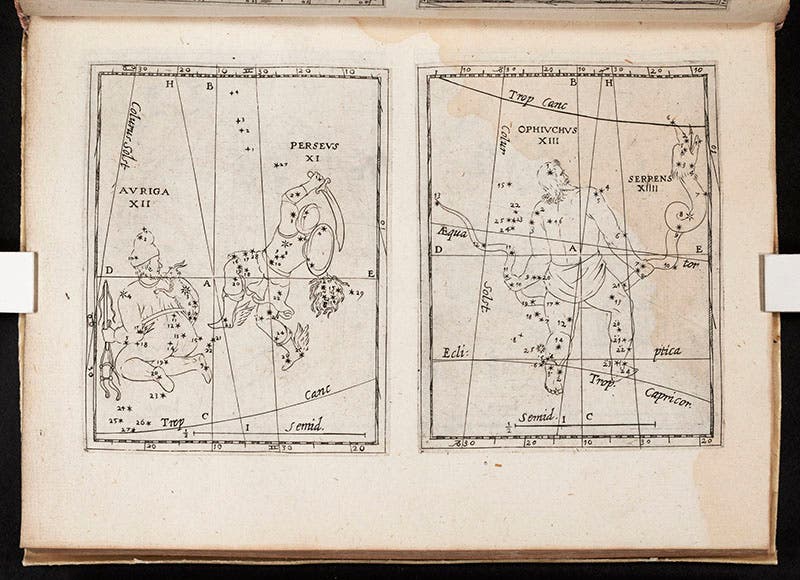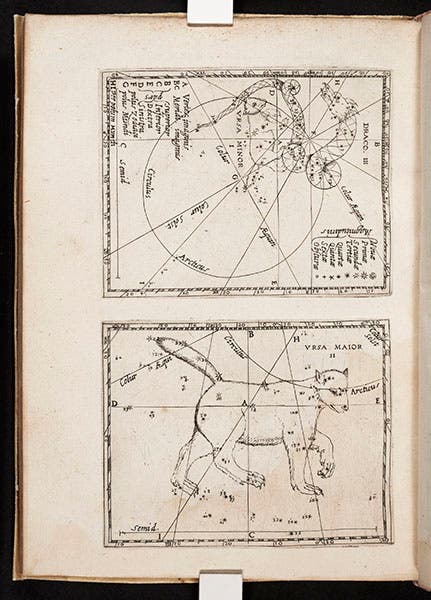Scientist of the Day - Christoph Grienberger
Christoph Grienberger, an Austrian Jesuit mathematician and astronomer, was born July 2, 1564, in the Tyrol. After spending some time in Vienna and Prague, he was transferred to the Collegio Romano. the Jesuit university in Rome, where he studied under Christoph Clavius, and then succeeded him as professor of mathematics when Clavius died in 1612. There is no known portrait of Grienberger.
Grienberger spent most of his career in Rome as a teacher, and as censor for Jesuit mathematics works of all kinds, where he displayed considerable skill in editing and helping authors such as Mario Bettini and Orazio Grassi. Grienberger published little himself, but one of his few books is a lovely treasure, a star catalog and atlas called Catalogus veteres ... cum novis (Catalog of ancient and modern [star positions],1612). The first modern star atlas had been published just nine years earlier in Germany, the Uranometria of Johannes Bayer, modern because it utilized the new star positions of Tycho Brahe, and because it included constellation figures of unusual beauty. Grienberger helped turn Bayer’s innovations into a tradition, as he too relied on Tycho Brahe’s star catalogue, as well as those of Clavius and a certain Franciscus Pissero of Siena, whose stellar observations are known only because Grienberger included some of them in his Catalogus.
Clavius’s depictions of star constellations are not nearly as attractive as those of Bayer, but they are unique, and well suited to the job of providing a background to the carefully positioned stars. There are 14 plates that accompany the catalog, which include 25 etchings, each etching depicting 1-3 constellations (there are 48 constellations depicted in the 25 etchings; Bayer had used 48 large engravings to show the same constellations).
We show here a sample of the constellation figures. Each constellation has a number that conforms to the traditional number in the star catalog of Ptolemy of Alexandria, where 1-21 are northern constellations, 22-33 are the constellations of the zodiac, and 34-48 are the southern constellations (Bayer had followed the same order in his Uranometria). Our first image shows two zodiacal constellations, Gemini and Cancer. We also see the northern constellations Auriga and Perseus, and Ophiuchus, two separate etchings on the same page (third image), and Argo and Canis major from the southern skies (fourth image).
One of the charms of early printed books is their idiosyncrasy – very few copies of the same edition are alike, because they were put together by hand. None of the leaves of plates in Grienberger’s atlas has any plate numbers or catchwords to indicate where they go in the book. So it would have been easy to get them out of order. In our copy, the star atlas starts right after the star catalog ends on page 88, and the first leaf of plates shows Cepheus, Cassiopeia, and Bootes, which are the 4th, 10th, and 5th northern constellations, and one immediately wonders, what happened to Draco and the two bears? Sure enough, they turn up later, right in the middle of the zodiacal constellations (fifth image). In most other copies, one presumes, they are in their proper lead-off position.
The Bayer atlas has a 49th plate with 12 new southern constellations recently discovered by mariners, but Grienberger’s atlas includes only the traditional 48. However, there is one novelty. In the depiction of Ophiuchus (third image, and detail, sixth image), there is a symbol near the left calf of the snake-bearer, with the number “25.” It is a different symbol from any other star on the page. If you consult the catalog, it identifies Ophiuchus 25 as “Stella nova anni 1604” – the new star of 1604 (seventh image). The nova of 1604 was an extremely bright new star – now known to have been a supernova – that had attracted the attention of astronomers everywhere, including Johannes Kepler, who wrote an entire book about it. But Grienberger’s is the first star catalog and atlas to include it. You can learn more about the nova of 1604 in one of our posts on Kepler
Our Library has an excellent collection of star atlases. We mounted an exhibition of these atlases in 1995, which we called Out of This World, but at the time we issued no catalog. In 2007, we remounted the exhibition, this time with a catalog, and since we had acquired some new celestial atlases in the interim, we published a second and accompanying catalog called Further Out, which described our 15 new acquisitions. The foremost of these was Grienberger’s atlas, which we acquired from the firm of Bernard Quaritch in 2000. It is item 2 in the catalog, and you can find it online here.
William B. Ashworth, Jr., Consultant for the History of Science, Linda Hall Library and Associate Professor emeritus, Department of History, University of Missouri-Kansas City. Comments or corrections are welcome; please direct to ashworthw@umkc.edu.










![Andromeda and Perseus, constellations figured by James Thornhill, with star positions determined by John Flamsteed, in Atlas coelestis, plate [15], 1729 (Linda Hall Library)](https://assets-us-01.kc-usercontent.com:443/9dd25524-761a-000d-d79f-86a5086d4774/1b30cfec-5be6-4297-a7fb-97255ba992e5/thornhill1.jpg?w=210&h=210&auto=format&fit=crop)


